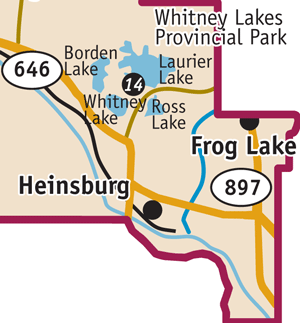 History of Heinsburg and Area
History of Heinsburg and Area
Much of early settlement of the Heinsburg area came up the North Saskatchewan River. In 1792 Fort George (NWC) and Buckingham House (HBC) were set up between Lindbergh and Elk Point. Later in 1823, Dog Rump House was built nearby to deal with the pemmican trade. Since land south of the North Saskatchewan was disputed territory by many First Nations groups, early trails like the Carlton trail from Winnipeg to Edmonton ran north of the river in Cree territory. Early NWMP had a post in Onion Lake to watch over large groups of bands living in the vicintity of Frog Lake. In 1885 this population became a major part of the North West Rebellion with considerable focus on the communities by the Canadian authorities. This is examined in the beginnings section of this website.
As Alberta and Saskatchewan came into being in 1905 this region began to be settled with few services available, partly due to the barrier of the North Saskatchewan River. In 1913 John Heins set up a post office and store in his home near the current Whitney Lake Provincial Park. The next year a ferry started 5 miles south. With the coming of the CNR in 1928, two elevators were built near the river and, like many communities, the town of Heinsburg moved to the Railroad. The train ran 6 nights a week to this end of line stop. A planned extension to Saskatchewan never happened. A hotel and church were built in Heinsburg. Phone service arrived in 1929. Stores were run by Ben Kates and Rudolph Gregor, among others, for many years. A drug store was run for a while by WB Cameron, only white male survivor of the Frog Lake hostilities. Many other businesses supported the community.
In the 1940s Heinsburg School became a centralized school site when many outlying schools were closed. In 1958 a new community hall replaced many smaller sites. In 1962 local power was replaced with regional power. Over the years many active sports clubs flourished in Heinsburg and curling has always been a popular winter sport there. In 1963 a new bridge replaced the ferry, bringing an end to an era. Good roads and easy access to other communities has changed Heinsburg’s business community. There is still an active agricultural industry and oil field work in the area. Community organizations are still active and at the site of the only standing railroad water tower, it has a flourishing train museum under development.
This website hopes to grow as families, organizations and businesses add their history to this compliation of information done in 1975. All text from the original book is marked with the Land of the Red and White logo on the upper right had side of the page![]() .
.


